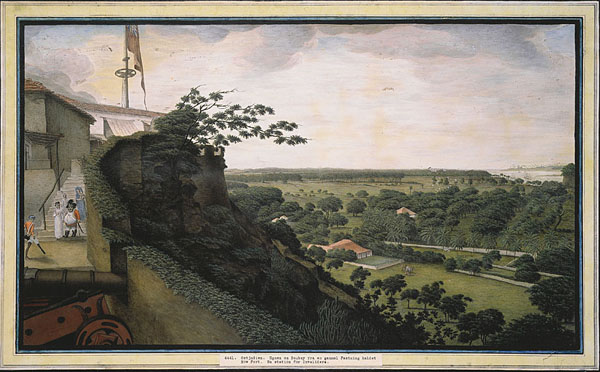

Sunday, December 19, 2010
Plate 11: View from Sion Fort, 1791-1792. In this second Plate [No. 11] James Wales provides an alternative panoramic view from the Sion Fort. From the vantage of Sion Fort, the view opens out to the island of Mahim. In this scene the walls of the fort dominate the foreground, with the curving line of the ramparts and an imposing cannon mounted in the battlement wall. The rising staircase and buildings behind the gun carriage are surmounted by a flagstaff asserting British sovereignty over the island. In other versions of this Plate there is no flag suspended on the flagstaff, so its inclusion here is an intriguing anomaly [cf: coloured etching held by Yale Center for British Art, listed as Plate 11, dated 1800, London]. The figures descending the stairs provide an ironic yet humorous counterpoint to the scene. There is the stout portly figure of an English military official whose waist is bursting from his red uniform, clearly the figure of a buffoon. He is accompanied by a European woman whose hand he holds; behind them follow two figures, one of whom is a woman carrying a small child. The status of these other women is unclear. The companion is clearly a figure of affection, while the woman in blue is presumably a nanny or wetnurse to the child. A one-legged, one-armed sepoy veteran stands waiting to greet the group, thereby highlighting the additional use of the fort as a sepoy hospital or hospice for military veterans. Once again the flat lands below the fort stretch into the indeterminate distance under a wide dominating sky. There are buildings and plantation areas with associated coconut palms in the middle distance, as well as thick clusters of native trees. On the far right of the picture, though significantly trimmed in this versio, is a pagoda, tomb or sati pavilion.
Subscribe to:
Post Comments (Atom)
No comments:
Post a Comment